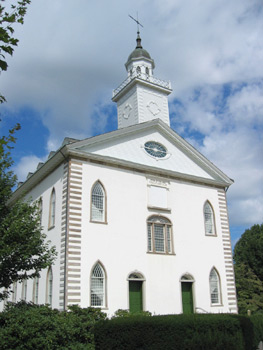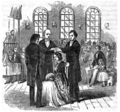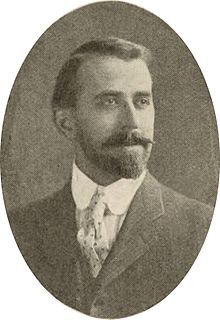Portal:Latter Day Saint movement
|
Welcome to the portal of The Latter Day Saint movement
Introduction The Latter Day Saint movement (also called the LDS movement, LDS restorationist movement, or Smith–Rigdon movement) is the collection of independent church groups that trace their origins to a Christian Restorationist movement founded by Joseph Smith in the late 1820s. Collectively, these churches have over 17 million nominal members, including over 17 million belonging to the Church of Jesus Christ of Latter-day Saints (LDS Church), 250,000 in Community of Christ, and several other denominations with memberships generally ranging in the thousands of members. The predominant theology of the churches in the movement is Mormonism, which sees itself as restoring again on Earth the early Christian church; their members are most commonly known as Mormons. An additional doctrine of the church allows for prophets to receive and publish modern-day revelations. A minority of Latter Day Saint adherents, such as members of Community of Christ, have been influenced by Protestant theologies while maintaining certain distinctive beliefs and practices including continuing revelation, an open canon of scripture and building temples. Other groups include the Remnant Church of Jesus Christ of Latter Day Saints, which supports lineal succession of leadership from Smith's descendants, and the more controversial Fundamentalist Church of Jesus Christ of Latter-Day Saints, which defends the practice of polygamy. (Full article...) General images -The following are images from various Latter Day Saint movement-related articles on Wikipedia.
Selected articleRalph Vary Chamberlin (January 3, 1879 – October 31, 1967) was an American biologist, ethnographer, and historian from Salt Lake City, Utah. He was a faculty member of the University of Utah for over 25 years, where he helped establish the School of Medicine and served as its first dean, and later became head of the zoology department. He also taught at Brigham Young University and the University of Pennsylvania, and worked for over a decade at the Museum of Comparative Zoology at Harvard University, where he described species from around the world. Chamberlin was a prolific taxonomist who named over 4,000 new animal species in over 400 scientific publications. He specialized in arachnids (spiders, scorpions, and relatives) and myriapods (centipedes, millipedes, and relatives), ranking among the most prolific arachnologists and myriapodologists in history. He described over 1,400 species of spiders, 1,000 species of millipedes, and the majority of North American centipedes, although the quantity of his output was not always matched with quality, leaving a mixed legacy to his successors. He also did pioneering ethnobiological studies with the Goshute and other indigenous people of the Great Basin, cataloging indigenous names and cultural uses of plants and animals. Chamberlin was celebrated by his colleagues at the University of Utah, however he was disliked among some arachnologists, including some of his former students. After retirement he continued to write, publishing on the history of education in his home state, especially that of the University of Utah. (Full article...) Selected locationThe Nauvoo Temple was the second temple constructed by the Church of Jesus Christ of Latter Day Saints. The church's first temple was completed in Kirtland, Ohio, United States, in 1836. In the winter of 1846, when the main body of the church was forced out of Nauvoo, the church attempted to sell the building, finally succeeding in 1848. The building was damaged by arson and a tornado before being demolished. In 1937, The Church of Jesus Christ of Latter-day Saints (LDS Church) reacquired the lot on which the original temple had stood. In 2000, the church began to build a temple on the original site with an exterior that is a replica of the first temple, but whose interior is laid out like a modern Latter-day Saint temple. On June 27, 2002, a date that coincided with the 158th anniversary of the death of Joseph and Hyrum Smith, the temple was dedicated by the LDS Church as the Nauvoo Illinois Temple. (Full article...)
Selected schismatic historiesCommunity of Christ, known from 1872 to 2001 as the Reorganized Church of Jesus Christ of Latter Day Saints (RLDS), is an American-based international church, and is the second-largest denomination in the Latter Day Saint movement. The church reports approximately 250,000 members in 1,100 congregations in 59 countries. The church traces its origins to Joseph Smith's establishment of the Church of Christ on April 6, 1830. His eldest son Joseph Smith III formally accepted leadership of the church on April 6, 1860 in the aftermath of the 1844 death of Joseph Smith. Community of Christ is a Restorationist faith expression. Still, various practices and beliefs are congruent with mainline Protestant Christianity. While it generally rejects the term Mormon to describe its members, the church abides by a number of theological distinctions unusual outside Mormonism, including but not limited to: ongoing prophetic leadership, a priesthood polity, the use of the Book of Mormon and the Doctrine and Covenants as scripture, belief in the cause of Zion, the building of temples, and an interpretation of the Word of Wisdom. In many respects, the church differs from the larger Church of Jesus Christ of Latter-day Saints (LDS Church) and most other Latter Day Saint denominations in its religious liberalism, belief in the traditional conception of the trinity (as opposed to a godhead of three separate and distinct beings), and rejection of exaltation and the plan of salvation. Salvation is considered a personal matter and not subject to dogma, but salvation by grace alone is emphasized. The church considers itself to be non-creedal and accepts people with a wide range of beliefs. Church teachings emphasize that "all are called" as "persons of worth" to "share the peace of Christ". (Full article...) OutlinesRelated portalsKey biographiesJohn Alpheus Cutler (February 29, 1784 – June 10, 1864) was an early leader in the Latter Day Saint movement who founded the Church of Jesus Christ (Cutlerite) in 1853. He had previously served in several church positions under Joseph Smith, founder of the Latter Day Saint movement, as well as captain of Smith's personal bodyguard and "Master Builder and Workman on all God's Holy Houses." Following the death of Joseph Smith in June 1844, Cutler at first followed the Twelve Apostles under Brigham Young, but later left Young's church to reorganize the Church of Jesus Christ, with himself serving as its first president. Cutler claimed that this was the sole legitimate continuation of Smith's organization, and he served as its leader until his death. (Full article...)
Selected image The Kirtland Temple, dedicated on March 27, 1836, making it the first temple to be built by adherents of the Latter Day Saint movement. Currently owned and operated by the Community of Christ.
Did you know (auto generated)
Selected Anniversaries
Selected quote
TopicsFeatured contentCategoriesWikiProjectsAssociated WikimediaThe following Wikimedia Foundation sister projects provide more on this subject:
Discover Wikipedia using portals | ||||||||||







































